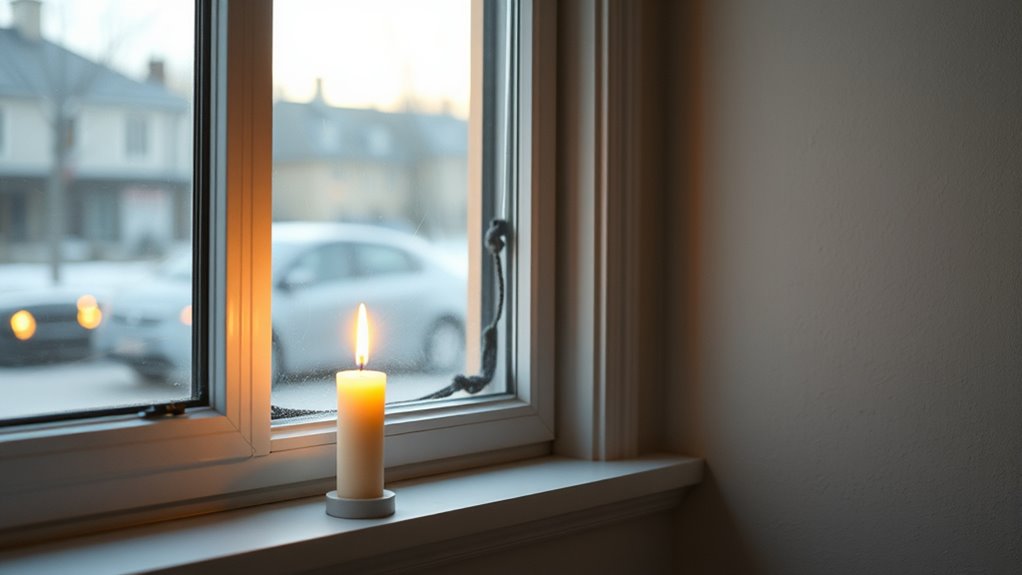To test for window drafts, many start with the candle trick—hold a lit candle near the frame and watch for flickering, which signals airflow. However, this method can miss subtle leaks and isn’t very precise. Better options include using an incense stick or smoke pencil, which produce a steady smoke trail that’s easier to see. For more effective detection strategies and sealing tips, keep exploring how to improve your home’s comfort and energy efficiency.
Key Takeaways
- The candle trick involves holding a lit candle near window edges to detect airflow by observing flickering.
- Candle flickering may be subtle or affected by indoor airflow, limiting accuracy.
- Using a smoke pencil or incense stick offers clearer, more visible airflow detection than candles.
- For comprehensive assessment, a professional blower door test identifies overall airtightness and hidden drafts.
- Proper sealing with weatherstripping or caulk based on accurate airflow detection improves energy efficiency and comfort.

Have you ever wondered how much cold air sneaks in through your windows during the winter? It’s likely more than you realize, and understanding airflow patterns can help you pinpoint exactly where these drafts originate. When you perform a window draft test, it’s essential to recognize the common draft sources—whether they come from gaps around the window frame, faulty seals, or even poorly installed windows. These draft sources create uneven airflow, making some areas of your home chillier than others. Identifying these patterns allows you to target your efforts more efficiently, saving you money on heating and increasing comfort.
A classic method many use is the candle trick. Light a candle and hold it near the edges of your window frame, slowly moving around to observe the flame’s flickering. If the flame flickers noticeably, it indicates airflow from a draft source nearby. This technique is simple and inexpensive, but it does have limitations. For one, it’s not always easy to see subtle flickering, especially in bright daylight, and the candle’s flame can be affected by indoor airflow or even drafts from other areas. Plus, the candle test doesn’t tell you the size or severity of the draft, nor does it help you identify hidden or hard-to-reach draft sources behind the window frame.
While the candle trick offers quick insight, it’s not the most thorough or reliable method. Better alternatives include using a smoke pencil or an incense stick, which produce a steadier, more visible trail of smoke that clearly shows the airflow pattern. These tools are more sensitive and easier to interpret, especially for detecting minor drafts. For a more detailed assessment, you can also perform a professional blower door test, which measures the overall airtightness of your home and pinpoints the most significant draft sources. This is more costly but provides extensive data, helping you prioritize which windows or areas need sealing or insulation.
Ultimately, the goal of any draft test is to identify where cold air sneaks in so you can take effective action. Whether you choose the candle trick or opt for more advanced tools, understanding airflow patterns and draft sources is key. Recognizing that air leakage can significantly impact your home’s energy efficiency helps you make smarter sealing decisions. Sealing gaps with weatherstripping, caulk, or window insulation kits can make a noticeable difference, keeping your home warmer and more energy-efficient. Recognizing the limitations of each method ensures you get the most accurate assessment, leading to smarter decisions and a cozier winter.
Frequently Asked Questions
How Can I Improve My Window Insulation Beyond Draft Tests?
To improve your window insulation beyond draft tests, start by sealing any gaps with weatherstripping or caulk to prevent drafts. Add window insulation film or thermal curtains for extra draft prevention. Consider installing double-glazed windows or adding window inserts to enhance insulation. Regularly check and replace worn seals, and use draft stoppers on sills. These steps considerably reduce heat loss and keep your home more energy-efficient and comfortable.
Are There Eco-Friendly Methods to Seal Window Drafts Effectively?
Ever wondered how to keep your home warm without harming the planet? Eco-friendly sealing options like reusable weatherstripping and natural fiber curtains are your answer. Sustainable insulation materials, such as sheep’s wool or cellulose, also effectively block drafts while reducing environmental impact. These methods not only cut energy costs but also support greener living. Why settle for synthetic solutions when you can choose eco-friendly sealing and sustainable insulation?
What’s the Average Cost of Professional Window Draft Sealing?
The average cost of professional window draft sealing ranges from $150 to $400, depending on your home’s size and the extent of window insulation needed. You’ll benefit from expert draft prevention techniques, ensuring your windows stay sealed and energy-efficient. While DIY methods can be cheaper, professional sealing offers more reliable results, ultimately saving you money on energy bills and enhancing your home’s comfort year-round.
How Often Should I Perform a Window Draft Test?
You should perform a window draft test at least twice a year to maintain ideal energy efficiency, ideally during seasonal shifts like fall and spring. Regular testing helps you identify drafts early, so you can seal leaks promptly. By doing this seasonally, you guarantee your home stays warm in winter and cool in summer, reducing energy costs and improving overall comfort. Keep an eye on changing weather conditions for the best results.
Can Window Drafts Affect Indoor Air Quality?
You might not notice, but window drafts can subtly influence indoor air quality. Poor air circulation caused by drafts can trap pollutants and humidity, potentially leading to allergies or mold growth. When drafts allow outside air to seep in, they disrupt the balance of indoor air, making it less fresh and healthy. Addressing drafts improves air circulation, helping your home stay cleaner, healthier, and more comfortable.
Conclusion
Remember, a candle test isn’t foolproof, but it’s a helpful starting point. If you feel drafts, don’t just ignore them—seal those gaps for comfort and savings. Sometimes, the simplest fixes work best, and as the saying goes, “A stitch in time saves nine.” Better alternatives like weatherstripping or door sweeps can make your home cozier and more energy-efficient. Don’t wait until the cold hits—take action now and keep the drafts out!









